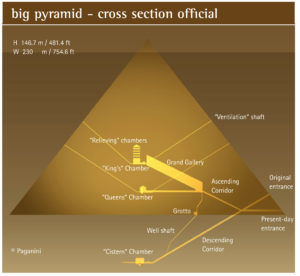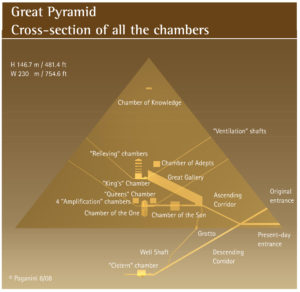“Cheops” Pyramid
The Great Pyramid
Like the “Mykerinos” Pyramid and the “Chephren” Pyramid, the “Cheops” Pyramid is perfectly aligned to the cardinal points. According to modern construction standards, tolerance limits range from one to three degrees, because such minor deviations are not noticeable to the eye. The deviations in the “Cheops” Pyramid are just hundreds of a degree, at the most just 3 arc minutes; even less than 2 arc minutes on the southern side (2 arc min. = 0.009%). The four sides at the base of the pyramid are practically the same length: the northern side measures 230.25 m / 755.41 ft , the western side, 230.35 m / 755.74 ft, and the southern side measures 230.45 m / 756.07 ft long. These minor differences add up to a deviation less than one tenth of a percent. “Cheops” Pyramid also stands absolutely level with a maximum of 16 millimeters / 0.63 inch height difference at its base. The corners form a perfect right angle, with a deviation less than 3 arc minutes and just 2 arc minutes on the northwest corner (89°5958). Such amazing precision goes far beyond modern construction standards.
There remain 201 intact stone layers with an average height of 0.7 m / 2.3 ft each. The remains of the 202th and 203rd layers lie on top of the square summit platform, which is approximately 10 m / 32.81 ft across in either direction. The upper 9.4 m / 30.8 ft of the pyramid are missing. The individual levels do not become successively thinner towards the top. Until the 17th layer, the height of the stone blocks decreases from 1.5 to 0.7 m / 4.92 to 2.3 ft, but those in the 19th layer are again 0.9 m / 2.9 ft thick. The blocks on the 35th level are larger and heavier (10 to 15 tons) than any others, except for those at the base. Above this level, the thickness of the layers slowly decreases and towards the top is just 0.5 m / 1.6 ft. The apex is located precisely above the center of the square base. Had the builders allowed even the slightest inaccuracy the deviation would increase considerably from layer to layer.
The “Cheops” Pyramid is situated exactly at the 30th parallel, or 29° 58 51, above the Equator. In The Fingerprints of the Gods, Graham Hancock (1995, 434-435) provides mathematical calculations that show that the minor deviation could have been intentional. If you want to effectively view the Earths axis at the 30th parallel then the atmospheric refraction must be taken into consideration. At the foot of the “Cheops” Pyramid this would match precisely the deviation that is indeed present. The meridian upon which the “Cheops” Pyramid stands leads through more continents than all others.
It is said that this north-south line cuts the global land masses in half. Technically speaking, it is actually Giza that would seem the ideal location for the 0° meridian, instead of Greenwich, England. Because the “Cheops” Pyramid is located at the 30th parallel, it is as equally distant from the center of the Earth as it is from the North Pole. It also sits on the line, which when followed around the globe, cuts the continents in half. The position of the “Cheops” Pyramid is thus a geodetic fixed point, which could only have been calculated by someone who knew the Earth to be a sphere and who had measurements of both the landmasses and the oceans! The base length (including casing stones) is 365,342 Egyptian cubits, which corresponds exactly to the number of days in a year. The steep 50° angle of inclination indicates the incorporation of the number Pi, because the height of the original pyramid, at 146.7 m / 481.4 ft, has the same ratio to the base (921.4 m / 3023.1 ft) as does the radius of a circle to its circumference (2 x Pi).
The pyramid is thus also a projection of the northern half of the globe, with the apex at the North Pole and the circumference (at the base) is the Equator. This makes the ratio of the circumference to height precisely 2 Pi (Hancock, Fingerprints of the Gods, 1995, 436). The enigmatic pyramid structure also resounds with many other interesting numerical combinations.
These, however, are hardly mentioned in text books, or are branded as made-up number games and random results, which were neither intended, nor recognized, by the builders. If it were merely a matter of the number Pi, then such explanations might be convincing. However, the pyramid have many other amazing mathematical peculiarities, among them, the number phi, the golden mean or ratio, which is mirrored in the dimensions of the “King’s” Chamber, the height of which (5.8 m /19 ft) perfectly matches half the length of the diagonals on the floor (11.6 m / 38.2 ft). Despite all these nearly unbelievable findings and masterly construction techniques, the true artistry lies within the body of the pyramid, in the chambers and corridors, which were not found until the 9th century because the original entrance was had been walled up and encased.
This is an excerpt from the book GIZA LEGACY.




